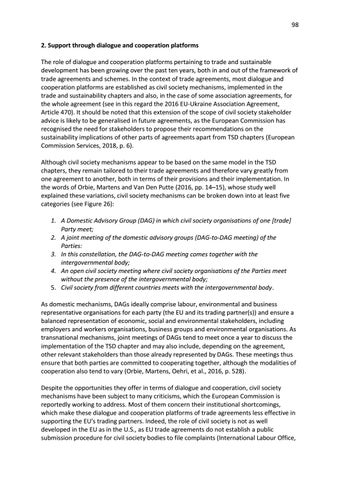98 2. Support through dialogue and cooperation platforms The role of dialogue and cooperation platforms pertaining to trade and sustainable development has been growing over the past ten years, both in and out of the framework of trade agreements and schemes. In the context of trade agreements, most dialogue and cooperation platforms are established as civil society mechanisms, implemented in the trade and sustainability chapters and also, in the case of some association agreements, for the whole agreement (see in this regard the 2016 EU-Ukraine Association Agreement, Article 470). It should be noted that this extension of the scope of civil society stakeholder advice is likely to be generalised in future agreements, as the European Commission has recognised the need for stakeholders to propose their recommendations on the sustainability implications of other parts of agreements apart from TSD chapters (European Commission Services, 2018, p. 6). Although civil society mechanisms appear to be based on the same model in the TSD chapters, they remain tailored to their trade agreements and therefore vary greatly from one agreement to another, both in terms of their provisions and their implementation. In the words of Orbie, Martens and Van Den Putte (2016, pp. 14–15), whose study well explained these variations, civil society mechanisms can be broken down into at least five categories (see Figure 26): 1. A Domestic Advisory Group (DAG) in which civil society organisations of one [trade] Party meet; 2. A joint meeting of the domestic advisory groups (DAG-to-DAG meeting) of the Parties: 3. In this constellation, the DAG-to-DAG meeting comes together with the intergovernmental body; 4. An open civil society meeting where civil society organisations of the Parties meet without the presence of the intergovernmental body; 5. Civil society from different countries meets with the intergovernmental body. As domestic mechanisms, DAGs ideally comprise labour, environmental and business representative organisations for each party (the EU and its trading partner(s)) and ensure a balanced representation of economic, social and environmental stakeholders, including employers and workers organisations, business groups and environmental organisations. As transnational mechanisms, joint meetings of DAGs tend to meet once a year to discuss the implementation of the TSD chapter and may also include, depending on the agreement, other relevant stakeholders than those already represented by DAGs. These meetings thus ensure that both parties are committed to cooperating together, although the modalities of cooperation also tend to vary (Orbie, Martens, Oehri, et al., 2016, p. 528). Despite the opportunities they offer in terms of dialogue and cooperation, civil society mechanisms have been subject to many criticisms, which the European Commission is reportedly working to address. Most of them concern their institutional shortcomings, which make these dialogue and cooperation platforms of trade agreements less effective in supporting the EU's trading partners. Indeed, the role of civil society is not as well developed in the EU as in the U.S., as EU trade agreements do not establish a public submission procedure for civil society bodies to file complaints (International Labour Office,
5 0 Billion Euros: Europe's Child Labour Footprint in 2019

Turn static files into dynamic content formats.
Create a flipbookArticles inside
Issuu converts static files into: digital portfolios, online yearbooks, online catalogs, digital photo albums and more. Sign up and create your flipbook.












